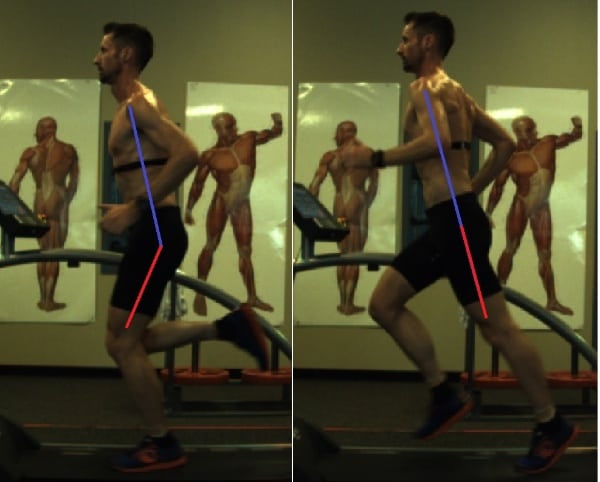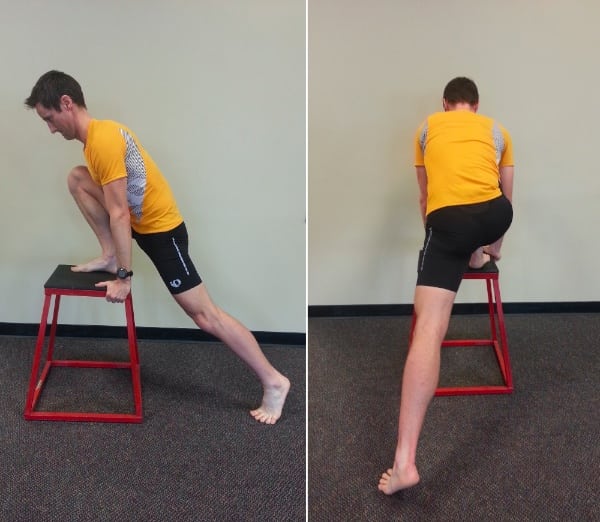 Low back pain is the most common physical ailment in the world. The majority of people will experience a low back pain episode at some point in their lives, often repetitively.
Low back pain is the most common physical ailment in the world. The majority of people will experience a low back pain episode at some point in their lives, often repetitively.
It is equally common among runners, though many runners tend to brush off low back stiffness and pain as part of the game, until it becomes debilitating. I, myself, have struggled with back pain for the better part of three years, until just recently. In retrospect, all of my low back pain was due to mechanical inefficiencies, as well as the unique demands of mountain trail running. But since reforming my stride, my back pain is almost completely gone.
Below are some critical strategies to limit low back stress and pain during running.
Background
Discussing the causes of low back pain in runners requires a review of my Four Concepts of Efficient Running Mechanics:
- Forward Trunk Engagement Through a Hip Hinge;
- The Short and Long Hip Pattern;
- Strong Arm Swing; and
- The Pawback.
Within this construct of efficient running is this fundamental mechanical theory:
- Flexion-dominant trunk stability
- Extension-dominant hip mobility
What that means is: to efficiently move forward, our trunk must be forward-oriented. This comes from hip flexion, but core stability is required to keep us trending forward without falling backwards. This could be why the vast majority of ‘core stability’ exercises deal with the anterior abdominal muscles.
At the same time, the way we propel is through hip mobility. The hips drive upward and downward, but the bulk of our propulsion in a gravity-dependent world comes from hip extension. Pushing off powerfully from the gluteal muscles is the central motor to fast, powerful, and efficient running.
That said, strong, efficient running requires this balance: flexion-dominant stability of the trunk, which provides a solid platform for powerful hip extension beneath and behind us.

The author demonstrating a trunk-forward stability with hip-extension push off equal to the trunk. All photos: Joe Uhan
It is when we lose this balance that problems arise, often in the low back and pelvis.
Low Back Pain: A Misfire in the System
When either hip mobility or trunk stability is lost, so is efficiency. With the former, if the hip cannot extend–either due to tightness or poor positioning–’the buck is passed’ onto the low back. For the latter, if the trunk does not stay stable, the hips lose the ability to powerfully push, and excessive mobility occurs at the trunk.
The Culprits
Hip-Flexor Tightness
Efficient running requires the hip extend to the level of the trunk. That is all. Yet, few of us–including runners–have that flexibility. Excessive sitting–the cornerstone of Western civilization–is likely the culprit, where our hips are stuck in a flexed position for hours at a time each day.
The hip-flexor muscles–the psoas, ilacus, and rectus femoris–all originate on the lumbar spine or pelvis, and insert onto the upper portion of the femur. They act to active flex the hip upward during running, but they also must passively relax to allow the thigh to extend. If the hip flexors become tight, any attempt to extend fully during the running gait will result in low back stress. Tight psoas muscles, especially, will pull on the lumbar spine–on which they’re connected–causing lumbar stiffness and possible low back pain.
Trunk-Stability Deficit
On the other end, the core-stability system must keep the trunk stable so that the hips have a strong base for push off. When the trunk–namely the lumbar spine and pelvis–fails to stay stable during the push off, excessive motion tends to occur. With each stride–180 per minute–the lumbar and pelvic joints are being stressed. This is a prime generator of low back pain and degenerative stress.
Too Upright
If one has flexible hips and a strong core, it is still possible to have back pain. Since hip extension equal to the trunk is the prime job of the gluteal muscles, what happens if the trunk is completely upright?
Besides providing forward momentum, the vial importance of a hip-hinged forward trunk is that it gives the gluteals somewhere to go. A forward trunk creates a rearward, propulsive glute push off. But running too upright robs the hip extensors of a place to go. As a result, the body often compensates by extending through the lumbar spine.

The author, a year ago, running too upright, with excessive active lumbar extension in push off. This compensatory motion caused significant back pain for years. But once corrected (previous photo), back pain was abolished.
This is extremely stressful to the low back, as the body is actively recruiting lumbar muscles to propel, which creates significant joint stress and overuse of a muscle group intended to stabilize and lightly rotate–not propel.
Excessive Trunk Rotation: ‘The Swivel’
A central component of a strong arm swing is the transfer of power from arms to the legs–and/or a counter-balance to the legs–using the trunk as a conduit. Inefficiency in the arm swing can cause a hyper-rotation, a ‘swivel-effect,’ where the arms twist from side to side, rather than pumping forward and back. This can cause the trunk to excessively rotate, often concentrating the motion in the lumbar spine.
Again, this left-and-right twist that propagates 180 times per minute creates a potentially enormous stress to the low back, often resulting joint wear and tear, and low back pain.
*****
In summary, low back pain can arise from:
- Tight hip flexors that fail to allow full hip extension, causing lumbar stress;
- Poor core stability, where the lumbar spine and pelvis fail to stay stable as the hip pushes off;
- Being too upright in the stride, resulting in compensatory extension from the low back; and/or
- Excessive trunk rotation due to an inefficient arm swing.
Low Back Pain Prevention: Exercises and Form Cues
Stretch The Hips!
The hip flexors must be flexible enough to allow hip extension equal to the trunk. A simple test of this involves lying on the edge of a table or bed and hugging one thigh tightly to the chest. The opposite upper leg should be able to remain fully level with the table, with the lower leg hanging close to 90 degrees.
This test, itself, is a stretch: passively hanging, or actively ‘pulling’ the leg toward the table and floor. This can be done for 30 to 60 seconds, for several reps, to improve hip-flexor mobility.
A great ‘on-the-go’ stretch, pre- and post-run, is what I call the ‘Split Hip Stretch.’ It involves putting a foot up on a step, bench, or any object two to three feet high.
The flexed leg should rest against the chest (with the knee behind to toes). The trailing leg is getting stretched by being slightly wide and fully extended. The stretch is created by actively squeezing the trailing leg’s glutes and quad muscles.
This exercise creates a combined flexion, extension, and abduction stretch for both hips, all the while protecting the low back from extension stress.
Hold for 20 to 30 seconds, for several reps, each side.

Split Hip Stretch
Trunk-Stability and Hip-Mobility Exercises
Practice trunk stability while extending the hips using these exercises:
All Fours Bent Knee Leg Extension
This exercise practices the ability to extend the hip on a stable trunk. Extend the bent-knee leg upward, careful to keep the low back and pelvis stable. The goal is to extend the thigh to the level of the trunk. However, only go as high as you can go without over-arching through the low back.
Hold three seconds or a single exhale. Alternate, 10 repetitions per side.

All Fours Bent Knee Leg Extension
Straight Leg Extension Plus Opposite Elbow
This exercises adds an opposite-elbow extension, working on arm coordination along with hip extension and trunk stability.
Extend the leg and opposite arm simultaneously. Hold three seconds or a single exhale. Do 10 repetitions in a row, per side.

Straight Leg Extension Plus Opposite Elbow
Plank Plus Leg Extension
This is an advanced strength exercise, combining an elbow plank with a straight-leg-extension lift.
Emphasis is on keeping the low back and pelvis stable, while the hip moves to a level equal to or just slightly higher than the level of the trunk.
Hold each extension three seconds or a single exhale. Alternate, 10 to 20 total repetitions.

Plank Plus Leg Extension
The Deadlift
As covered in the August 2014 column, the Runner Deadlift exercise works hip-extension strength and mobility with a stable trunk. Practice this exercise as indicated.
Form Cues for Low Back Pain Prevention
The Hip Hinge
Maintaining neutral-forward-trunk momentum is the most important element of low back pain prevention. Besides preventing over-striding, a trunk-forward position allows the hips to extend without over-arching the low back. Keeping the trunk forward and neutral is vitally important during mountain trail running. Avoid backward leaning–and significant low back stress–by maintaining the hinged-hip position, even on steep downs!
Strong, Efficient Arm Swing
While a small amount of trunk rotation is ideal in an efficient stride, excessive ‘swivel’ of the trunk on the pelvis is stressful to the low back. Work on a strong forward and back arm swing where the elbows drive powerfully rearward. Efficient arm swing should create approximately an inch or so of trunk rotation in each direction, but no more. The exercises outlined in this column are useful in developing arm-swing efficiency.
Lumbar Stability in Extension
While lumbar extension and rotation can be stressful and pain producing, a lumbar-extended position is not only okay, but desirable. Neutral spine mechanics involve a moderate amount of extension curvature. This helps orient the pelvis and hips for optimal rearward hip push off.
However, it is excessive lumbar-extension motion that is stressful. Be careful that you are not allowing the low back to repetitively extend during the stride. While actively ‘tensing’ the abdominals during running is neither desirable or sustainable, some degree of stability in the low back is required to prevent this excess motion.
The stability exercises above will help train the brain to maintain this stability when running.
When in Doubt, Film It!
If you’re unsure if you’re adequately hip hinging, or stabilizing, have someone watch you run and give you feedback, or hold your camera phone to take a quick side-view video. This ubiquitous tool may be the most powerful way for runners to monitor their stride. Be sure the trunk is forward-oriented, and the low back stable. In the front or rear view, be sure there is only an inch or so of trunk rotation, with a strong forward and back arm swing.
We Walk How We Run
Be mindful of your walking form. The same inefficient habits–too stiff in the hips, too upright (or backward leaning), and too much arching or rotation can just as often occur when walking. Be sure to maintain a light, forward trunk and extend powerfully with your hips behind you, even when walking. Efficient walking begets efficient running!
*****
Low back pain can put a damper on a lot of things, and, over time, it can jeopardize your running career. Take these steps to ensure you limit back stress, and maximize hip mobility and strength over the course of your run.
Call for Comments (from Meghan)
- Do you suffer from low back pain when you run? How long have you suffered and do you know what might be the mechanical cause of your pain?
- Have you addressed any of the running-form issues discussed in this article in your own running gait? If so, what issues did you previously have and how did you correct them?
